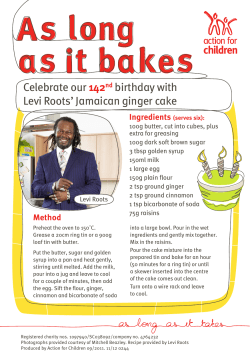
You will need the following materials for 0.2 hectare (half... - Two 200 litre (45 gal) drums, each half-full with
You will need the following materials for 0.2 hectare (half acre): Two 200 litre (45 gal) drums, each half-full with clean water 340 kg (750 lb) planting pieces, 3-5 cm (1-2 in)long with all soil removed. 1.4 kg (3.5 lb) Topsin-M fungicide plus required amount of sticker (Follow sticker label) At least 4 clean poly bags (e.g. fertilizer, onion, chicken bags) Water-proof gloves or strong, water-proof plastic bags; sturdy sticks to mix fungicide. An accurate watch or other time-piece. . . . Topsin-M fungicide gave good results in one diseased plot. Further tests are to be done. RURAL AGRICULTURAL DEVELOPMENT AUTHORITY Caution: Do not handle treated pieces with bare hands. Use gloves or plastic bags (no holes). Do not use food, feed or water containers (e.g. buckets, basins) to hold treated ginger or chemical. Wash with soap after Leaf spots (Fig. 7) Ginger is affected by leaf spots which are usually not severe. In recent years however, serious cases have been seen. Leaves may have small, whitish spots with yellow edges; these get larger and spread, making the leaf yellow then brown, killing it. Early in the crop, it can cause severe losses. Fusarium spp., Rhizoctonia spp. and Pseudomonas solanacearum have been found in diseased leaves. harvested hands of ginger fig. 7 Introduction Reaping Plants mature and turn yellow around October/ November and dry down by December/January. The reaping period is December to May: Fresh market ginger reaped first and dried reaped nearer May. Loosen soil with a fork, carefully lift hands and remove soil, to avoid breaking. Animal-drawn ploughs damage and bury hands much more. Wider row spacing is better if tractors or animal ploughs are used. Fill with water mix Average yields in central Jamaica are 13-18 tonnes/ hectare (5-7 tons/ acre) of green ginger, being lower in sandy soils and for the Tambric type. In India, the main types planted, yield similarly to Jamaica; in Hawaii, 44 tonnes/ hectare (17 ton/ acre) is reported, using their larger green ginger types. Ginger is a herb that, once planted, grows year after year. Each year, it bears parts called hands (Fig. 1), in the soil. Hands put out branches (fingers) which sprout shoots as they grow out. Leaves make food and store it in hands. As days get shorter, leaves dry down naturally and hands reach mature size. The next year, these new hands sprout (ratooning) and the plant spreads further. Fresh ginger produces 20% (one-fifth) its weight as peeled, dried ginger. Growing Areas, Soils, Locations 2 1 For further information consult your RADA officer 3 Prepared by fig. 5 fig. 6 The Ministry of Agriculture is developing a project to rescue the industry. This leaflet is to help growers raise yields and quality of green ginger. Field support, marketing and research will also be provided. The Plant Yield Topsin For many decades, the quality of Jamaican peeled dried ginger has remained the best in the world, commanding the highest prices. The industry has the potential to earn US$ 964,000 and generate J$ 32 million income to farmers. However, a new disease, low production and high prices threaten to destroy this. Phillip Chung, Subject Matter Specialist, RADA 1999 May 04 The major ginger-growing areas are 450-900 metres above sea level, in the hilly areas of central Jamaica, where the parishes of Manchester, Clarendon, St. Ann and Trelawny meet. Ginger grows well on many types of soils in Jamaica. Best results come from clay loams with a good supply of organic matter. The crop cannot withstand waterlogging. The crop will bear well from sea level to over 1500 metres above. In central Jamaica, it is inter-planted with yams or in the open, by itself. In other countries, fields are planted on flat land, using tractors and other machines. Ginger will bear in the shade (e.g. areas of Hanover, under dense trees). Traditionally, land left in ruinate for a few years gives best results. Major Pests and Diseases Ginger Rhizome Rot (GRR)- This disease has hit the main gingergrowing areas since 1995. It worsened each year and in 1997, around half of the crop was destroyed. ground level 4-8 cm Rainfall 15-20 cm 30-45 cm Ginger requires at least 1500 mm per year, with a short dry season around harvesting time. The crop is irrigated in other countries. . .. fig. 3 Land Preparation . . 1-3 months before planting, plough soil at least 30 cm (1 ft.) deep and allow to weather (burn). On heavier soils, cut drains to remove excess water. Refine land shortly before planting. Add organic matter at refining. For well-broken down manure, do so about one month before planting. Fresh manure may need 2-4 months. Planting Material . After reaping, select well-formed hands, with many fingers,to plant. Break these into planting pieces and store in a cool, shaded area. Farmers plant large pieces, as this "barampa" is later sold with the hands that it bears. Small pieces, 3-5 cm (1-2 in.) long with 2-3 branches will bear just as well. This is important as planting material must now be treated with chemical and is both scarce and expensive. By April/ May, the tips of fingers push out and turn pinkish/ yellowish, as sprouting begins. This is the best time to plant. Reaped barampa sprout only one or two shoots, giving poor yields. . . fig. 4 Planting Cut furrows using a hoe and place pieces in the bottom. Use soil from the second furrow-cut to cover pieces in the first; from the third, to cover the second and so on until the entire field is planted out (Fig.2). Cover pieces 4-8 cm (1.5-3 in.) deep. Tractors use a reverse disc after each furrow-blade; pieces dropped from the gang are covered by the disc. Animal-drawn ploughs are followed by someone dropping pieces and covering. Spacings (Fig. 3) give 110,000 - 218,000 plants per hectare (44,00087,000 plants per acre). . . .. To control the disease, several things must be done. Do not plant ginger from affected areas in those which do not show the disease. In central Jamaica, use planting material only from fields which showed little or no disease. Select only healthy-looking hands: Break and inspect insides for off-colour and rot. Avoid land which showed disease, for planting. Treat planting material with fungicide as follows: i. Place about 34 kg (75 lb) planting pieces in each bag. ii. In a bucket or similar container, pour about 5-10 litres water, add all the fungicide and mix well. Add the amount of sticker shown on the label and again mix well (Fig. 6). Pour the mixture into one drum then top up with water and mix well (Fig. 6). Fertilizer Although ginger is often not fertilized in Jamaica, much higher yields are possible with fertilizer. This is more important with land that is not rested. Twelve to seventeen 50 kg bags per hectare (5-7 bags per acre) of 14-28-14 are normally broadcast and chopped into the soil at refining. 18-18-18 is better for very acid soils. iii. Weed Control v. It is best to avoid land infested with nutgrass as this weed is very difficult to remove. It will pierce the hands and form "nuts" inside them. It may even reduce the size and yield in infested parts of a field. fig. 2 The disease is caused by germs (Fusarium spp., Pythium spp., Pseudomonas spp.) These are spread in the ginger and soil, on tools, shoes, etc. It is more destructive in wet conditions. Sprouted pieces will emerge from the ground within 5-10 days, depending on moisture. Using a hoe, do the first weeding at moulding (6-8 weeks after planting). Two or more weedings may be needed. A machete is best used later, to avoid damage to hands. fig. 1 It affects all parts of the plant. Leaves droop, turn yellow and plant tops are easily pulled away from the root. The plant dries and falls over before normal (Fig. 4). Hands may look healthy outside or rotted (Fig. 5). Inside, hands are a lighter or darker colour than normal. Normal-looking hands placed in storage, rot after several weeks, if they are diseased. iv. . Pour half of this mixture into the empty drum, giving two drums, to speed up dipping (Fig. 6). Dip each bag for 20 minutes. Move the bag up and down every 5 minutes to stir. Make sure the bag is covered by the mixture each time. Spread pieces out to dry first or plant wet. Treat soil after planting, with the used mixture.
© Copyright 2025



















